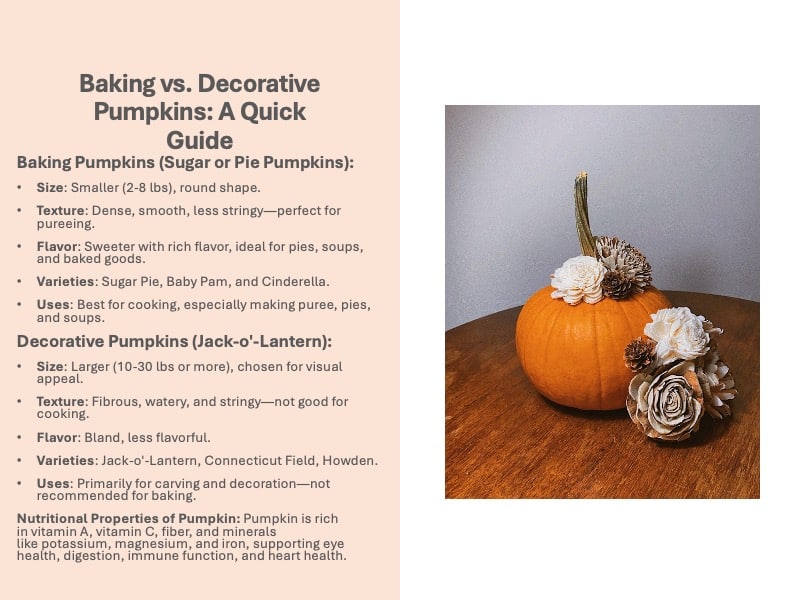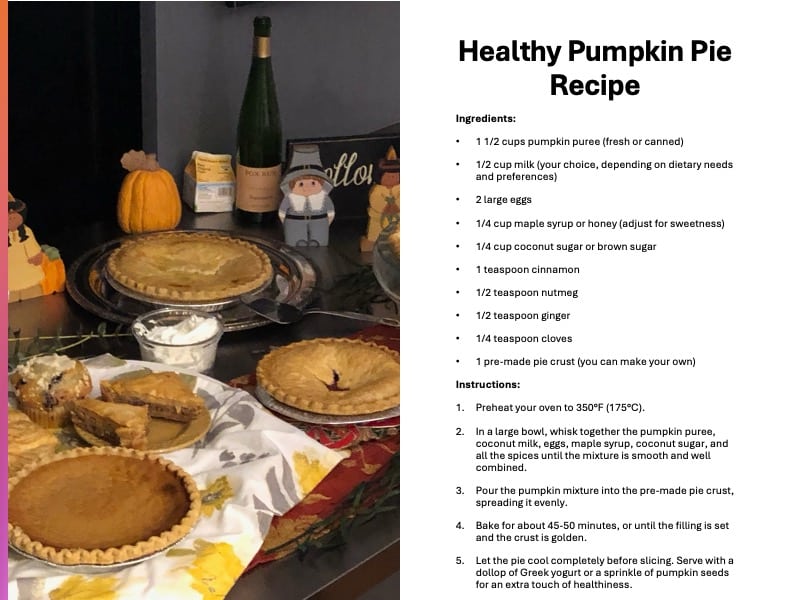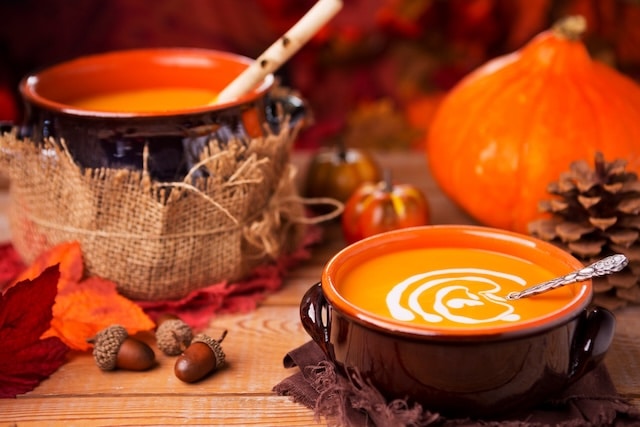Top 5 Health Benefits of Pumpkin: Pumpkins Are Great for You!
Pumpkin isn’t just for Halloween or your favorite seasonal latte—this versatile ingredient deserves a spot in your kitchen all year round. Rich in vitamins, fiber, and antioxidants, pumpkin can elevate both the flavor and nutritional value of a variety of dishes, from breakfast to dessert.
Its mildly sweet and earthy taste, coupled with a creamy texture, makes it a perfect addition to smoothies, soups, snacks, and even baked goods.
Whether you’re looking to boost your immune system, fuel your workouts, or satisfy a craving for something sweet without the guilt, pumpkin is a nutrient-packed powerhouse you’ll want to include in your daily diet.
Here’s how you can make the most of this autumn treasure, along with a healthy pumpkin pie recipe that’s sure to become a new favorite!
Difference Between Baking Pumpkins and Decorative Pumpkins

Not all pumpkin varieties are created equal.
Baking pumpkins and decorative pumpkins may look similar on the outside, but they have significant differences in texture, taste, and intended use.
Key Points
- When choosing a pumpkin for your next recipe, opt for baking pumpkins like Sugar Pie or Baby Pam. These varieties offer a sweet taste and smooth texture that are ideal for cooking.
- Decorative pumpkins, on the other hand, are best left for carving and festive decorations, as their taste and texture do not lend themselves well to culinary use.
Baking Pumpkins (Sugar Pumpkins or Pie Pumpkins)
- Size and Shape: Baking pumpkins are typically smaller, weighing between 2 to 8 pounds, and have a round, uniform shape.
- Texture: The flesh of baking pumpkins is dense, smooth, and less stringy, making it ideal for pureeing and using in recipes.
- Flavor: These pumpkins are sweeter and have a richer, more concentrated flavor, which enhances the taste of dishes like pies, soups, and muffins.
- Varieties: Common baking pumpkin varieties include Sugar Pie, Baby Pam, and Cinderella pumpkins, all of which are cultivated for their superior taste and texture.
- Uses: Baking pumpkins are perfect for culinary purposes, such as making pumpkin puree, pies, bread, soups, and other dishes where texture and flavor are key.
Nutritional Properties of Pumpkin
Pumpkin is low in calories yet high in vital nutrients, making it an excellent choice for anyone looking to improve their diet. It’s packed with:
- Vitamin A: Pumpkin is exceptionally high in beta-carotene, which your body converts to vitamin A, supporting eye health and immune function.
- Vitamin C: This powerful antioxidant helps protect your cells from damage, supports skin health, and enhances immune response.
- Fiber: Dietary fiber in pumpkin aids digestion, helps regulate blood sugar levels, and can assist with weight management.
- Minerals: Pumpkin is a good source of potassium, magnesium, and iron, all of which are crucial for heart health, muscle function, and overall well-being.
Decorative Pumpkins (Jack-o’-Lantern or Field Pumpkins)
- Size and Shape: Decorative pumpkins are larger and come in a variety of shapes, often chosen for their visual appeal. They can range from 10 to 30 pounds or more.
- Texture: The flesh of decorative pumpkins is more fibrous, watery, and stringy, making them less suitable for cooking and pureeing.
- Flavor: These pumpkins have a bland taste with a less intense flavor, which is why they are rarely used in cooking.
- Varieties: Popular decorative pumpkin varieties include the Jack-o’-Lantern, Connecticut Field, and Howden pumpkins, all of which are bred primarily for size and sturdiness.
- Uses: Decorative pumpkins are best suited for carving, seasonal displays, and other ornamental purposes. They are not recommended for baking or cooking due to their texture and lack of flavor.
Health Benefits of Pumpkin
Pumpkin is a versatile and nutritious food that offers a wide range of health benefits, from boosting immunity and supporting eye health to aiding in weight loss and improving skin quality. I
ncorporating this nutrient-dense vegetable into your diet can significantly enhance your overall well-being, making it a valuable addition to your meal planning year-round.
1.) Boosts Immunity
The vitamin A and C content in pumpkins enhances the immune system, helping your body fight off infections more effectively.
Vitamin A strengthens mucous membranes in the respiratory tract, acting as the first line of defense against pathogens. Meanwhile, vitamin C boosts the production of white blood cells, which are essential for fighting infections.
2.) Promotes Eye Health
Beta-carotene in pumpkin plays a significant role in protecting vision, especially in low-light conditions, reducing the risk of age-related macular degeneration.
Beta-carotene converts into vitamin A in the body, which is essential for maintaining the health of the retina and preventing oxidative stress that can damage eye tissues over time.
3.) Supports Heart Health
Pumpkin’s potassium levels help manage blood pressure, reducing the risk of hypertension.
A higher potassium intake is linked to a reduced risk of stroke and heart disease, as it helps counteract the effects of sodium in the body.
Combined with its fiber content, pumpkin also aids in lowering cholesterol levels by binding to bile acids in the digestive tract, which facilitates cholesterol excretion from the body.
4.) Aids Weight Loss
Pumpkin is low in calories but high in fiber, which helps keep you feeling full longer, reducing the temptation to overeat. Fiber slows the absorption of sugar into the bloodstream, stabilizing blood sugar levels and preventing sudden hunger spikes.
This makes pumpkin an ideal food choice for anyone looking to manage their weight effectively without feeling deprived.
5.) Improves Skin Health
The antioxidants in pumpkin, particularly vitamins C and E, protect the skin from damage caused by free radicals, promoting a healthier and more youthful appearance.
Vitamin C also plays a crucial role in collagen synthesis, which helps maintain skin elasticity and reduce the appearance of wrinkles.
The beta-carotene in pumpkin also offers natural UV protection by minimizing the damage caused by sun exposure.
6.) Promotes Muscle Growth
Pumpkin can be an excellent addition to a muscle-building diet due to its rich nutrient profile, making it a powerful ally for bodybuilders and athletes striving to maximize their performance and recovery.
In addition to its high potassium content, which is crucial for muscle function and recovery, pumpkin is also packed with carbohydrates that can fuel workouts and replenish glycogen stores post-exercise.
The natural sugars and complex carbohydrates in pumpkin are easily digestible, providing a sustained release of energy that supports prolonged physical activity.
This makes pumpkin one of the best carbohydrates for bodybuilders or athletes, as it helps maintain energy levels during intense training sessions and promotes quicker recovery afterward.
Potassium in pumpkin aids in maintaining proper electrolyte balance and enhancing muscle contraction during workouts, making it invaluable for improving workout performance and muscle endurance.
Moreover, pumpkin seeds are a good source of plant-based protein, offering essential amino acids that play a direct role in muscle protein synthesis and repair.
The combination of carbs and protein in pumpkin and its seeds creates an ideal nutrient balance for post-workout recovery, helping to rebuild muscle fibers damaged during exercise.
Lastly, the iron content in pumpkin seeds also supports oxygen delivery to muscles, boosting energy production and sustaining endurance during high-intensity training.
7.) Enhances Digestive Health
Pumpkin is exceptionally beneficial for digestive health due to its high fiber content. The dietary fiber in pumpkin adds bulk to the stool, which helps regulate bowel movements and prevent constipation.
Pumpki’s fiber content makes it one of the best prebiotic food sources, as it feeds the good bacteria in your gut and promotes a healthy microbiome balance.
A well-balanced gut microbiome is linked to improved digestion, enhanced nutrient absorption, and even a stronger immune system.
Pumpkin’s antioxidants also help reduce inflammation in the gut, further supporting digestive health and reducing symptoms of gastrointestinal disorders.
How Much Pumpkin Should You Eat Per Day?
Incorporating pumpkin into your daily diet can be highly beneficial, but moderation is key.
A serving size of about 1 cup of cooked pumpkin (245 grams) is generally recommended for daily consumption.
This amount provides an ample dose of vitamins and fiber without excessive calorie intake, making it easy to integrate into most dietary plans.
Who Should Avoid Pumpkin?
For the majority, pumpkin is safe and nutritious. However, certain individuals should be cautious:
- Those with Pumpkin Allergy: While rare, some people might be allergic to pumpkin and should avoid it altogether.
- People with Kidney Issues: Due to its high potassium content, individuals with chronic kidney disease should consult their healthcare provider before increasing pumpkin intake.
Organic vs. Non-Organic Pumpkin: Which Is Better?
Choosing between organic and non-organic pumpkins can be a concern for many health-conscious consumers.
- Organic Pumpkin: Grown without synthetic pesticides and fertilizers, organic pumpkins are less likely to contain chemical residues. They are often considered the healthier and more environmentally friendly option.
- Non-Organic Pumpkin: Typically more affordable and widely available, non-organic pumpkins can still be a nutritious choice. However, it’s essential to wash them thoroughly to reduce exposure to potential pesticide residues.
How to Add More Pumpkin to Your Diet

Incorporating pumpkin into your diet is both easy and versatile, as its mild flavor and rich texture blend seamlessly into a variety of dishes.
Here are some delicious and creative ways to enjoy more pumpkin, with the added bonus of a healthy pumpkin pie recipe to satisfy your sweet tooth.
Smoothies and Soups

Adding pureed pumpkin to your smoothies not only boosts their nutrient content but also provides a creamy texture and natural sweetness. Try blending pumpkin with ingredients like banana, Greek yogurt, almond milk, cinnamon, and a drizzle of maple syrup for a fall-inspired smoothie.
For savory options, pumpkin makes a fantastic base for soups.
You can create a hearty pumpkin soup by combining pumpkin puree with vegetable broth, coconut milk, garlic, and spices like nutmeg, cumin, and paprika.
Baking
Pumpkin puree is a game-changer in baking, offering moisture and a nutrient boost to your favorite treats. Swap out some of the oil or butter in recipes for pumpkin puree when making muffins, bread, pancakes, or even brownies to reduce fat content while adding fiber and vitamins.
For a nutritious breakfast option, try pumpkin oatmeal pancakes topped with a dollop of Greek yogurt and a sprinkle of nuts or seeds.
Healthy Pumpkin Pie Recipe
Pumpkin pie doesn’t have to be a guilty pleasure. This healthy version is made with wholesome ingredients, making it a nutritious dessert choice that you can enjoy without compromising your diet.
Ingredients:
- 1 1/2 cups pumpkin puree (fresh or canned)
- 1/2 cup coconut milk (or any plant-based milk)
- 2 large eggs
- 1/4 cup maple syrup or honey (adjust for sweetness)
- 1/4 cup coconut sugar or brown sugar
- 1 teaspoon cinnamon
- 1/2 teaspoon nutmeg
- 1/2 teaspoon ginger
- 1/4 teaspoon cloves
- 1 pre-made whole-grain or almond flour pie crust
Instructions:
- Preheat your oven to 350°F (175°C).
- In a large bowl, whisk together the pumpkin puree, coconut milk, eggs, maple syrup, coconut sugar, and all the spices until the mixture is smooth and well combined.
- Pour the pumpkin mixture into the pre-made pie crust, spreading it evenly.
- Bake for about 45-50 minutes, or until the filling is set and the crust is golden.
- Let the pie cool completely before slicing. Serve with a dollop of Greek yogurt or a sprinkle of pumpkin seeds for an extra touch of healthiness.
This healthy pumpkin pie recipe is lower in sugar and fat compared to traditional versions, and it incorporates natural sweeteners and whole ingredients, making it perfect for a nutrient-rich treat.
Snacks
Roasted pumpkin seeds are not just tasty; they are also packed with healthy fats, protein, and important minerals like magnesium and zinc. Season the seeds with your favorite spices—such as chili powder, garlic salt, or cinnamon sugar—before roasting them for a crunchy, satisfying snack.
You can also toss pumpkin seeds into trail mixes or use them as a crunchy topping for salads and yogurt.
FAQs About Pumpkin
- Can you eat pumpkin raw? Yes, pumpkin can be eaten raw, but it’s often more palatable and digestible when cooked or pureed.
- Is pumpkin good for your gut? Absolutely, the fiber content in pumpkin supports digestive health by promoting regular bowel movements and acting as a prebiotic for beneficial gut bacteria.
- How does pumpkin support heart health? The potassium and fiber in pumpkin help regulate blood pressure and reduce cholesterol levels, contributing to better cardiovascular health.
This website does not provide medical advice. This website site does contain affiliate links, and purchases may earn a commission.
Read my Medical Disclaimer, Review Disclaimer, and Publishing Policies for more details. Use of this site indicates acceptance of these terms.



